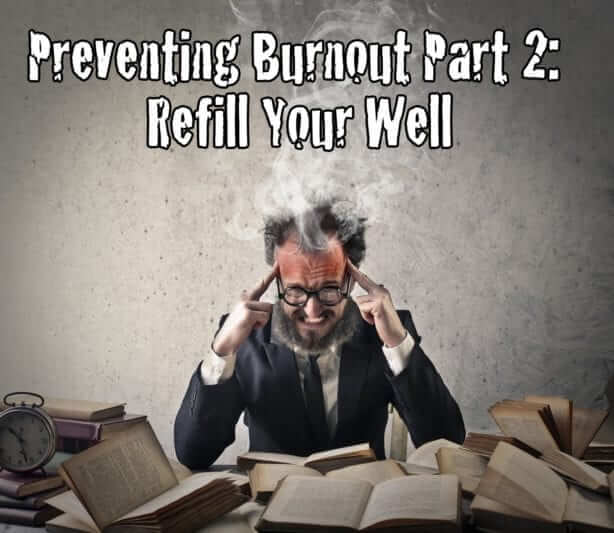Preventing Burnout — Part II: Refill Your Well
The following is the first part of our “preventing teacher burnout” series presented by our colleagues at TeacherCoach.
Burnout may be a complex set of factors extending beyond the work life of a given teacher. If we consider Mrs. D, the veteran teacher who retired early, we might assume her decision was only based on her displeasure with work. What if we learn that she was struggling with family issues that limited her patience or health issues that led to playing catch up when she missed school?
In a recent survey by this author, 97.1% of teachers indicated that personal growth would be an essential ingredient to supplement professional development. This finding is fascinating because it supports another finding that 97.3% of teachers acknowledged that stress in one’s personal life impacts work in the classroom.
If we combine the duress in one’s personal life with the plummeting job satisfaction over the past 25 years it’s not always easy to decide whether professional is impacting personal or the other way around. We can safely speculate that personal duress outside of work that doesn’t allow us to replenish our battery, reducing our tolerance for work distress.
Other than chronic stress, such as loss or other longer lasting pains outside our control, we have a greater ability to improve our wellness outside of school to better endure the challenges of our job. The first way we will do that is to consider a hidden paradigm you may be guided by, without any sense of how it’s influencing your life. This paradigm is simply what we do when we ‘hear the sound of the cannon’- work towards it or walk away.
The first important question to answer is to what degree I avoid pain or seek pleasure? Teachers who resonate more closely with avoiding pain, are more likely to suffer burnout and here is an oversimplification of how this works. Step one, we future focused, worried about what may be. High tension levels like a car idling too high, creates strain on our motor. Step two, we start to use up our resources, like that same car needing more frequent oil changes, but due to our lack of self-care, we don’t get them done. Step three, when unpleasantness happens, we grow resentful toward the world for seeming unfair, growing even more cautious.
It’s not unusual to be driven by fear (avoidance of pain), in fact fear may be the single greater motivator for a human being. This includes the fear of real and perceived threats, risks, and experiencing life outside our comfort zone. Given the choice between seeking pleasure or avoiding displeasure, fear seems to keep many in a place of avoidance, whether this is deflecting conflict with a significant other or shying away from controversial topics in the classroom so we don’t upset parents.
What if we avoid the potential for pain or displeasure when our radar for fear is mis-firing or calibrated to underestimate our ability to tolerate discomfort? We might interpret something as harmful when in fact the rewards far outweigh the risks, or better yet the act of avoidance serves to artificially strengthen our fear. We can never build our resiliency if we give in to fear and discomfort, resigning ourselves to a life of simple existence.
If you are beginning to question your own paradigm, then you are on the right track. We want to ensure we aren’t at either end of the continuum, hiding in a cave where the world can’t hurt us or constantly taking risks that endanger our health. Try answering these few questions to get you thinking about where you are along the continuum:
- Would I ask to join a new group of teachers eating lunch I don’t know well?
- Do I order the same food on the menu because I know I’ll like it?
- Do I bring up controversial topics in class or fear parent reactions?
- Do other teachers see the person I am outside of school?
- Do I find sharing my innards takes a lot of trust or do I spill my guts freely?
If you find yourself more conservative, tending toward avoiding pain, or risk more as those who seek out pleasure are, how might this be impacting your life? You might even consider how your teaching is influenced, but most importantly whether the benefits and limitations of living the way you are is leading you toward fulfillment or despair. To ensure we are living as deliberately and purposefully as we would like, will allow us to make changes in this paradigm to potentiate greater happiness.
If we live in survival mode where avoiding pain is a stronger force than seeking pleasure, we will grow our potential for toxic stress that leads to burnout. Pain is one of the only constants in life and it’s not to be avoided, but instead to be met head on. As we grow our tolerance for distress by:
- Strengthening our support network by teaching people who we need and not suffice with what they offer.
- Nurture ourselves with good food, rest, and fun to balance out the unpleasantness in our lives.
- Let go of control with regard to situations or people that are outside our sphere of influence- we will appreciate that dis-ease is not something happening to us, but within us.
While we still need to address the conditions in our personal and professional lives that create undue strain, following these guidelines and recognizing the forces that motivate our actions, will help us to spend more energy on those activities that refill our well.
This article is written by Jared Scherz, Ph.D., M.Ed. and CEO, of TeacherCoach a professional and personal teacher health site.





